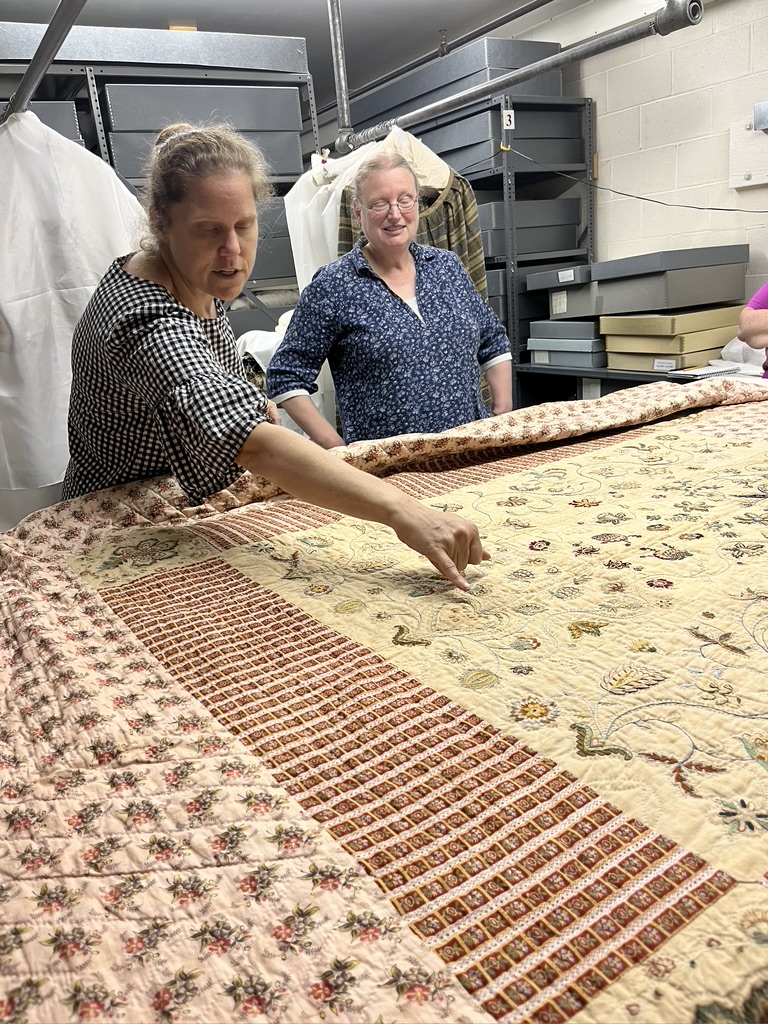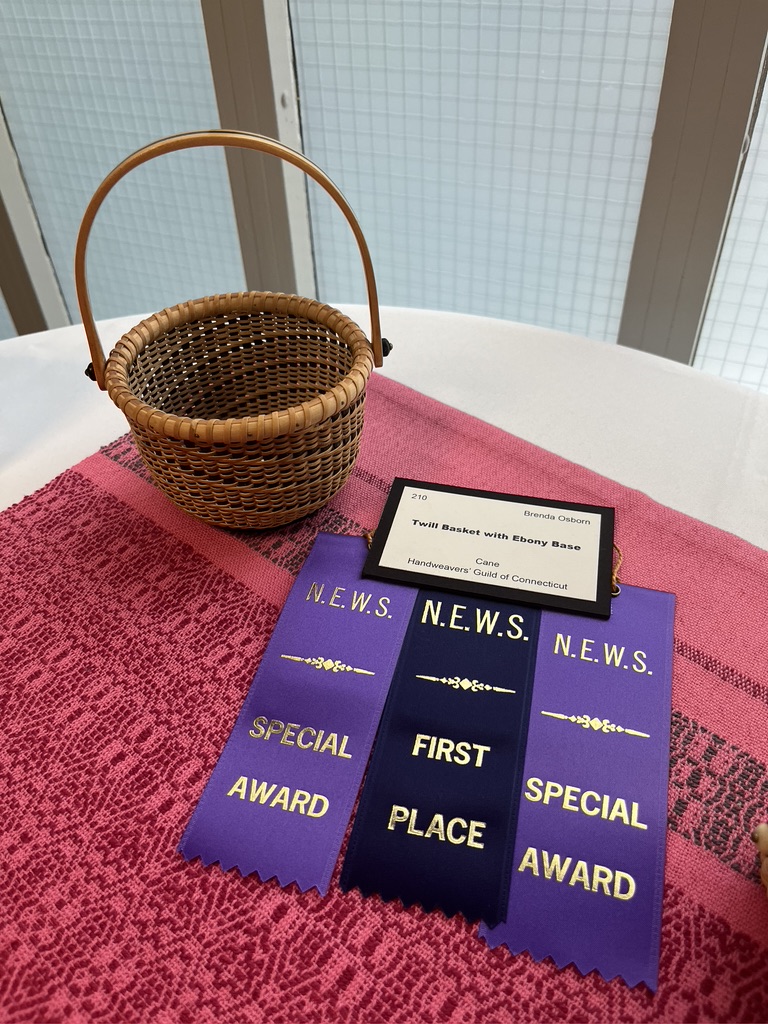It’s summer in New England in an odd numbered year, which means that regional weaving conferences are taking place throughout the US. NEWS is an acronym for New England Weavers’ Seminar. I haven’t attended this conference since 2017. Can you imagine how much I regret not going in 2019, since 2021 was canceled? I could not have predicted what would happen so soon after that 2019 summer conference that I missed.
It was invigorating to reconnect with weavers throughout New England after a six year hiatus. I had five wonderful days of inspiration from other weavers and teachers and vendors! The conference took place at a new location this year. The conference has long been held at Smith College, but this year it moved to Worcester State University. It was a bit longer drive for me, but it had so many pluses. All venues have their pluses and minuses, but I think the pluses at WSU outnumbered the minuses, and I cannot say that about Smith College.

The campus was easy to navigate, even when toting a floor loom with equipment; the food was quite good, and the weather was simply perfect–warm days with breezes and low humidity, cool nights. It was a stellar five days!
The coordinators arranged for a tour of Old Sturbridge Village for those of us not in classes on Thursday. I took advantage of that. We first had a tour of the stored collection of historic textiles. They have a trove of handwoven household items from well known New England weavers, such as Peace and Patience, a mother and daughter whose last names I neglected to learn! There were items from other early colonists as well, but I was too busy gazing at the beautiful fabrics to retain any names. Clearly, I cannot be trusted to listen when in the presence of handwoven goods.
The linen towel on top is woven in twill which was known as diaper cloth, and no!–this does not mean it was a diaper. This is the name given to utilitarian fabrics that were used in household situations, which does include diapers as we think of them today. They are hard wearing and absorbent, as well as beautiful. The wool blanket behind it is wool with natural dyes.
When first entering the storage facility at Sturbridge, we were confronted by high shelves loaded with historical weaving and spinning tools. Swoon!
There are handwritten records of weaving drafts, often written on the backs of paper that had been first used for other purposes.
This towel has an attached fringe. Elaborately knotted fringes were quite popular in the mid-19th c, and they were added on rather than done with warp threads. Since they had been added, if the fringe began to deteriorate, it could be removed, leaving the hemmed towel in good condition.
The museum has record books of payments for woven goods. The weavers were not always paid in currency at this time. This pitcher was payment for the blanket in the background, and there is a record that weaver was not happy with this outcome for her work. The blanket is all wool, with indigo dyed stripes. It is quite large, and pitcher is not!
We also saw a marvelous quilt made to accentuate a beautifully embroidered purse. Purses from this time period were usually drawstring bags that were worn inside a skirt with a slit that allowed access to the purse. Our guide explained that this particular purse may have been a treasured memento to the woman who designed an entire quilt around the purse.
The purse is the slightly more discolored rectangle in the center of my photograph. The quilter has matched the embroidery for the center of the quilt and added borders. I don’t remember the date of this quilt (mid to late 19th c), but it is in terrific condition. It was definitely treasured.
And then there were all the handwoven coverlets, of which we only saw a few! They are stored on rolls on rolling shelving, and there are a lot of them.

For every coverlet and counterpane there is an identifying card.
Upstairs in the collections building were lots of spinning wheels, wool winders and other tools. Our guide was particularly enthusiastic about a flax spinning wheel made by a man named Higginbotham who was from Pomfret, Connecticut and Cranston, Rhode Island, born in the mid 18th c. It is a still a beauty!
A shelf of band looms and a yarn swift.
Our guide told us that most of the textiles seen in the museum are reproductions, not the actual historical pieces. This is due to the fragility of textiles. Many of the reproductions are woven by the weavers at the village. This woman is weaving a patterned linen cloth that can become serviettes (napkins) as well as being pieced together to make a tablecloth. It’s a brilliant idea to warp a loom for the napkins and then piece the tablecloth in three sections. With a warp 24″ wide you can hem for 20″ dinner napkins and then piece three longer lengths together to get a tablecloth in the 60-64″ width.
It was lucky that some of the enactors were also dyeing on the day I visited. Logwood and madder.
After lunch and a time for exploring on our own, we had a tour of the ‘herb’ garden, which is quite large on three terraced areas. The garden includes dye plants, as well as plants that were used in finishing clothing (teasels and soapwort), and plants to be made into cloth, like flax.
Our guide has been working in the gardens of Sturbridge Village for over 40 years. She has been instrumental in changes to the gardens during this period, and since she is also a spinner and dyer she is knowledgeable about gardening as well as how these plants were used. Her name happens to be Higginbotham, perhaps not spelled quite that way. I wish I had asked her if she was related to the man who made that flax spinning wheel.
One thing I saw in the museum that she later talked about was milkweed silk. During this time period women with the luxury of time, or who could sell this product, made elegant wraps out of the fibers found in the seed pod of milkweed. You had to use it before the pods opened so that the silky fibers were still neatly nestled in the pod. Our gardening guide is making one herself. The fibers are bound together with sewing thread in little bundles and then attached to handwoven fabric.
Here are some scenes from Sturbridge Village that captured my attention. It is a beautiful place.
And interior views of the exhibits.
And then the formal events at NEWS started. I took one class that covered the rest of the days at the conference. I had trouble finding enough time to visit the exhibit halls and the vendors. My class was so wonderful that I didn’t mind too much. It was Wedge Weave with Connie Lippert. More on that shortly.
One of the memorable exhibits at this year’s conference was titled “Legacy Weavers,” and it honored the women of guilds in New England who have left us such a wonderful legacy of instruction, woven fabrics, and the memory of their unique personalities. Here is the tribute to Connecticut weaver, Mary Elva Erf. I remember being so thrilled that a member of my guild had published a book (Weaving Shaker Rugs). Now there are quite a few published weavers in the Connecticut guild, including me!

The most moving tribute (for me) was to Sarah Fortin. She passed away far too soon, and she left me marveling at many of the techniques she used. I didn’t know her well, but one workshop I took with her will always be a high spot in my weaving history. I regret that I don’t have a photograph of her tribute board. I guess I was too busy reacting to the loss of her. But here is one of her wonderful dimensional fabrics. She was also a talented sewist.
All the exhibits were well done. It’s been six years since I’ve been exposed to so many wonderful woven items. There were two handbags that I hope will lead me to some good ideas for making one of my own. One member of my Connecticut guild made a dress, handbag and shoes out of her handwoven fabric. It should have gotten an award! Another guild friend got first place in rugs for her rya knotted rug depicting flowers in a friend’s garden.
One of my baskets got three awards: 1st Place in Miscellaneous (I guess that’s the category for baskets!), and two special awards for ‘best historical inspiration’ and ‘best off-loom weaving.’ I am thrilled!
With the ribbons we each get buttons made from handwoven fabrics. It is such a wonderful memento to have.
My wedge weave class with Connie Lippert was a great choice. I’ve got so many ideas swimming around in my head at this point. It is quite dizzying. Not only did we all learn wedge weave, but also how to insert some ‘normal’ tapestry weaving into a wedge weave design, along with a few other intriguing techniques. I now know I can spend the winter aboard Pandora trying out some of these ideas. I am indebted to Connie for her generosity in showing us so many techniques, and even delving into the details of finishing.
This is my piece in progress. It’s not a fast technique, but I’m impressed with how much I managed to do in 2 1/2 busy days. The warp is 12″ wide and I’ve woven about 6″ in height.
In the space of five days I visited airports three times. I’ve never gone to an airport so many times in such short period without taking flight myself! I dropped Bob at Bradley on Wednesday so he could fly to Florida to visit his brother. Later that day I picked up Connie Lippert at Logan. Then on Sunday, I picked up Bob from Bradley as I drove home. What a whirlwind! It was all great. And, returning home I am enjoying the bounty of July in New England. The sunflowers are from a friend and the zinnias and peaches came from our local farm stand that Bob visited this morning.
Now to make use of the many inspirations from NEWS. I hope I can be productive for the rest of my time on land.
































